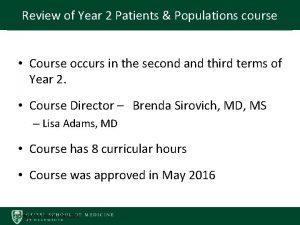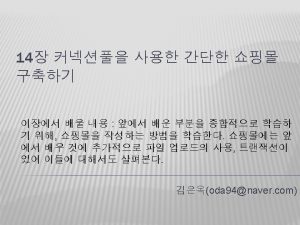Year 2 Patients Populations course Request Patients Populations





- Slides: 5

Year 2 Patients & Populations course: Request • Patients & Populations Year 2 – MEC approved May 2016 • 8 contact hours, with plan for gradual increase over time – Big picture: Applying capabilities developed in Year 1 (Data, Evidence, Context of Medicine, Systems) to contemporary issues • Inter-professional Education – 2 h Patient Safety Simulation Session (existing) • Case Series: 6 hours for three newly developed cases: Opioid Crisis, Vaccine hesitancy, International Research Ethics – Leadership: • Brenda Sirovich, MD, MS – P&P Course Director • Lisa Adams, MD – P&P Year 2 Course Co-Director

Year 2 Patients & Populations course: Request • Patients & Populations Year 2: Course Review – Scheduled Summer 2017 in conjunction with P&P Year 1 Course Review – Review Preview: • Course emphasizes engaged / active learning, with students independent investigation in preparation, and interactive student-led case discussions • Strong representation of Health & Values content • Individualized assessment • Student evaluations of course and specific evaluation of IPE experience overall favorable (overall 3. 9) • Course / session objective mapping requires revision

Year 2 Patients & Populations course: Request • Patients & Populations Year 2: Action Plan Preview – Overall course structure and assessment methodology to remain – Plan for changes will be detailed at f/u, including: • Gradual expansion with request (now) for up to 5 added hours in AY ‘ 17 -18 – Additional IPE type session focused on challenging communication issues – Added Case (Obesity/Nutrition) – Increased emphasis on Evidence and Data domains, separately, with added Biomed Libraries workshop • Attention to objectives, modifications to assessments, including added peer professionalism & participation

Year 2 Patients & Populations course: Request Thank you

Year 2 Patients & Populations course: Objectives # Course Objectives (using P&P Year 1 course 24 -objective numbering system) Session 2 Explain the role and use of statistics in addressing questions in health and medicine. Case Series 3 Explain the findings of a research study reported in the medical or health care literature. Case Series 4 Apply the findings of a research study to a clinical scenario. Case Series 7 Identify and compare strategies for the care of a population or community, or subgroups within it, based on your interpretation of patterns of disease and health care. 8 Explain the impact of social, behavioral, environmental, economic, cultural and personal factors on the health of individuals and populations. 9 Illustrate the relationships between the health care system and other societal systems and entities that impact population health. 11 Discuss the context (financial, political, ethical, e. g. ) in which medicine is practiced in the United States, and how it influences health care delivery. 14 Analyze leadership challenges at the personal and health care (clinical, educational, research, policy, or community service) team level. 18 Analyze, measure, and perform tests of change to demonstrate measurable improvement. Case Series Case Series IPE 19 Demonstrate appropriate behaviors while working effectively in inter-professional teams. IPE 20 Apply core patient safety concepts while recognizing the physician's role in monitoring and creating safe systems of care. IPE 21 Practice clear and concise communication with individuals or larger audiences, using writing, speech or visual elements. All 22 Demonstrate active, perceptive, and respectful listening. All 23 Formulate effective communication to articulate vision, develop relationships, and effect change. All 24 Evaluate a real world problem by effectively organizing, prioritizing, and synthesizing information into a plan for action. Case series









